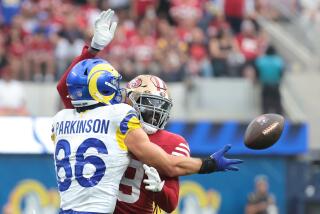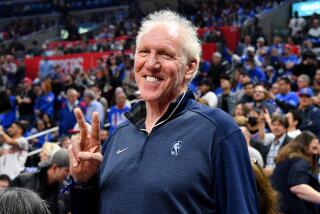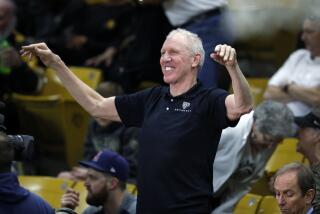Carterâs Short Passes Provided Pattern for Walshâs 49er Success
SAN FRANCISCO â Virgil Carter was never what you would call an accomplished quarterback with the Cincinnati Bengals. He was not exceptionally mobile, his throwing range was roughly 15 yards in any one direction, and the only way he will ever get into the Pro Football Hall of Fame is to pay his four bucks at the front door like the rest of us.
But Carter, or âVirgâ as he was known during his Bengals days in the early â70s, can make one claim to fame. He can accurately boast that it was his throwing arm, as meager as it might have been, that ultimately made the San Francisco 49ers the dominant team in the NFL today.
With little debate, the 49ers have been the class of the league since 1981. They won their first Super Bowl that year, completing a 16-3 season with a 26-21 victory over Cincinnati. They rebounded from a 3-6 record during the 1982 strike year to reach the NFC Championship game in 1983 (losing to Washington, 24-21). And they capped it all off with their second Super Bowl title in four years last January, whipping a talented Miami team, 38-16.
And, in a roundabout way, the 49ers have Carter to thank.
Carter had a quarterback coach at Cincinnati by the name of William Walsh, who had spent the 1969 season, just the second year for the expansion franchise, weaning a young potential superstar in Greg Cook. Walsh knew the kid was destined for success. âCook was just a great quarterback,â said Walsh. âMaybe the best to ever play the game.â
But Cook was not long for the starting lineup. A shoulder injury sent him to the sideline early in the 1970 season, and when Walsh looked down the bench for a backup, Carter was all he could find.
âThe only choice we had,â Walsh remembered, âwas to build our offense around what Virgil could do. And believe me, the short pass was all he could. He was a great competitor, and a great team leader, so we just played into his strength.â
Using the short pass as his bread-and-butter play, Carter became a master at the ball-control offense--wracking up lots of first downs, although not necessarily a lot of points, and giving the defense plenty of time to rest. After the Bengals started 1-6, Carter made the system work and rattled off seven consecutive victories. The Bengals finished with an 8-6 record and their first divisional title.
Encouraged by the results, Walsh maintained the system with every new quarterback he coached. When a rookie named Ken Anderson arrived in 1971 from tiny Augustana College, Walsh tried the experiment all over again with much the same success. As offensive coordinator at San Diego years later, he turned Dan Fouts into a franchise. As head coach of Stanford, he guided Guy Benjamin and Steve Dils to back-to-back NCAA passing titles.
And finally, four months after taking the reins of a hapless (2-14) 49er franchise in January of 1979, Walsh drafted Notre Dameâs Joe Montana in the third round and went to work again.
The results have been well documented. Relying mainly on the same ball-control offense developed at Cincinnati, Walsh and Montana overcame rebuilding years in 1979 (2-14) and 1980 (6-10) by leading San Francisco to its two NFL championships in the past four years.
And credit it all to Virgil Carter.
âIt really isnât a complicated philosophy,â Walsh explained. âWe try to control the ball and build up a number of first downs. If we can get 25 or 30 first downs, it generally means the defense has had time to regroup. Itâs a systematic ball-control style of offense.â
The results on the scoreboard were reflected in the statistics. In 1984, the 49ers ranked second in the NFL in average points per game (29.7), second in offensive yards (397.9), third in rushing yards (154.1), fourth in passing yards (243.8), second in fewest sacks allowed (1.7) and first in fewest turnovers (1.4).
âI donât know that itâs a unique idea,â Walsh said of his system. âWe have a lot of contemporaries and they all have their own systems and style. But it came to us out of necessity. You can develop a high-percentage passing game without great personnel. It doesnât mean you can play great defense, and it doesnât mean youâre going to score a lot of points. But it does mean youâll have a grip on the game at least until the fourth quarter. Thatâs pretty much how our lean years were spent.â
The lean years (which included a 59-14 loss to Dallas in 1980) were not necessarily lacking in approach and effort, but were simply short of talent. Of the 24 defeats the team suffered in those two years, 11 were by a touchdown or less.
âWe really werenât that bad a team,â said receiver Dwight Clark, most famous for his leaping touchdown catch over Dallasâ Everson Walls in the NFC Championship game in 1981, a catch that put the 49ers into Super Bowl XVI. âWe just didnât have any talent. Thereâs a difference. We could tell what we were trying to do was right, itâs just that we didnât have the people to pull it off. Thatâs whatâs been so much fun over the last couple of years, watching Bill bring in the talent to make the system work.â
Little by little, using any method available, Walsh went about acquiring talent. He started signing free agents, many of them castoffs from other teams like kicker Ray Wersching (Chargers). He worked trades for players that would fit well into his system--like Freddie Solomon (Dolphins) and Wendell Tyler (Rams).
The result was a rebuilding job perhaps unequaled in quantity and quality.
âNow we have a team with much more balance and obviously more experience,â said Walsh. âAt first, we worked within the framework of the offense. Then, as we added guys like (running backs) Roger Craig and Wendell Tyler, we broadened the offense so that we could absorb their abilities.â
Meanwhile, on the other side of the ball, the transformation on defense was just as gradual, yet just as effective. Walsh had adopted two philosophies from legendary coach Paul Brown, under whom Walsh worked in Cincinnati. The first was to run a very professional franchise, instituting an almost IBM approach from the first day of training camp until after the Super Bowl.
And the second was a desire for outstanding athletes on defense, with emphasis on quickness and hitting.
âDefinitely he wants hitters, but more important is the quickness,â said cornerback Ronnie Lott, one of the best in the NFL in both those respects. âHe always says that weâre going to make mistakes on the football field, but if you play hard and get to the ball, you can make up for that. I think thatâs one reason why we gave up a lot of yards statistically last year (10th in the NFL against the rush, 7th against the pass) but we didnât let many people in the end zone (1st in fewest points allowed). Weâd work our butts off to get to the play.â
Again, the addition of talent has made the San Francisco defense work. Walsh acquired Fred Dean from the Chargers, and made him a pass-rush specialist used only on obvious passing downs. He picked up starting defensive backs Lott, Eric Wright and Carlton Williamson all in the 1981 draft, a year after obtaining the fourth starter, Dwight Hicks, as a free agent.
Other draft picks, such as linemen Dan Bunz and Jim Stuckey and linebackers Riki Ellison and Keena Turner, along with other acquisitions such as Jack Reynolds (a free agent) and Louis Kelcher (obtained from the Chargers in a trade), helped the 49ers improve at a record pace.
In the two seasons from 1982 to 1984, the San Francisco defense jumped from 22nd in the NFL in points allowed to 1st (22.9 to 14.2), from 21st in average yards allowed to 10th (337.2 to 323.5), from 21st in rushing yards allowed to 7th (133.2 to 112.2) and from 25th in sacks to 11th (1.7 to 3.2).
âThe key is, he knows what he wants and he goes after it,â said starting defensive lineman Michael Carter, a former SMU guard and Olympic silver medalist in the shot put. âIf you donât fit into what theyâre trying to do, then you wonât be around here very long.
More to Read
Go beyond the scoreboard
Get the latest on L.A.'s teams in the daily Sports Report newsletter.
You may occasionally receive promotional content from the Los Angeles Times.










